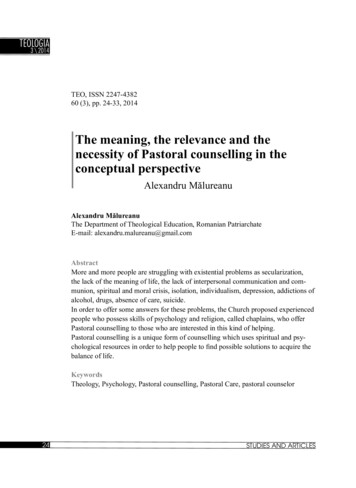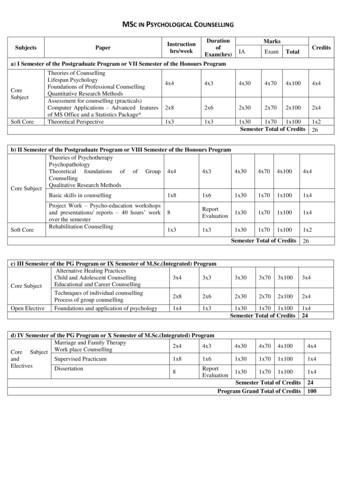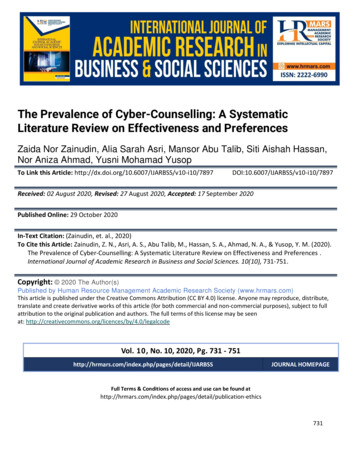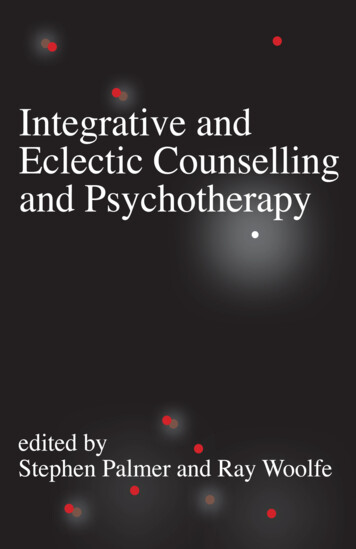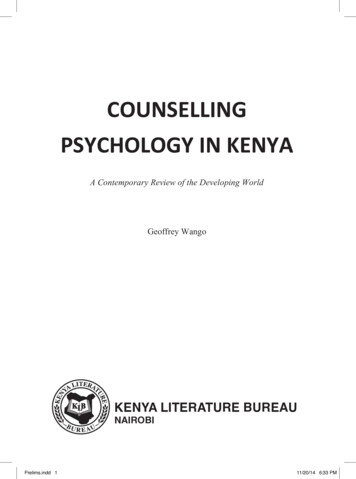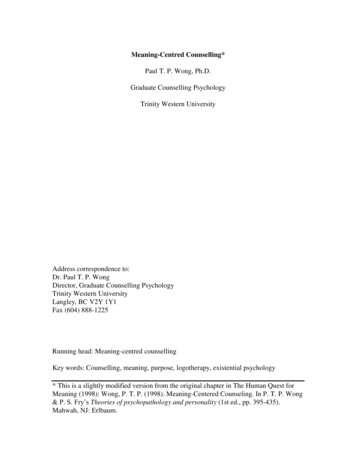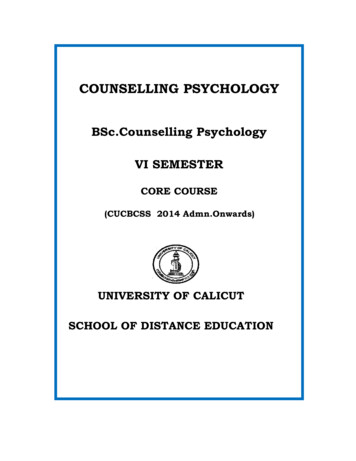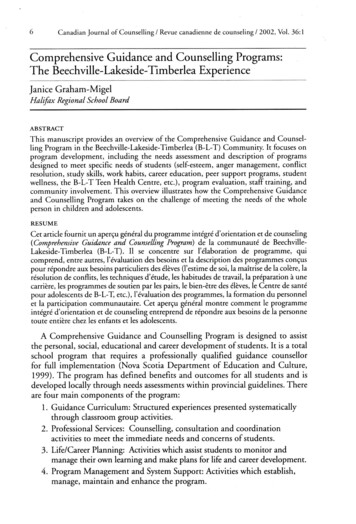
Transcription
6Canadian Journal o f Counselling I Revue canadienne de counseling I 2002, V o l . 36:1Comprehensive Guidance and Counselling Programs:The Beechville-Lakeside-Timberlea ExperienceJanice G r a h a m - M i g e lHalifax Regional School BoardABSTRACTThis manuscript provides an overview of the Comprehensive Guidance and Counselling Program in the Beechville-Lakeside-Timberlea (B-L-T) Community. It focuses onprogram development, including the needs assessment and description of programsdesigned to meet specific needs of students (self-esteem, anger management, conflictresolution, study skills, work habits, career education, peer support programs, studentwellness, the B-L-T Teen Health Centre, etc.), program evaluation, staff training, andcommunity involvement. This overview illustrates how the Comprehensive Guidanceand Counselling Program takes on the challenge of meeting the needs of the wholeperson in children and adolescents.RESUMECet article fournit un aperçu general du programme intégré d'orientation et de counseling{Comprehensive Guidance and Counselling Program) de la communauté de BeechvilleLakeside-Timberlea (B-L-T). Il se concentre sur l'élaboration de programme, quicomprend, entre autres, l'évaluation des besoins et la description des programmes conçuspour répondre aux besoins particuliers des élèves (l'estime de soi, la maîtrise de la colère, larésolution de conflits, les techniques d'étude, les habitudes de travail, la préparation à unecarrière, les programmes de soutien par les pairs, le bien-être des élèves, le Centre de santépour adolescents de B-L-T, etc.), l'évaluation des programmes, la formation du personnelet la participation communautaire. Cet aperçu général montre comment le programmeintégré d'orientation et de counseling entreprend de répondre aux besoins de la personnetoute entière chez les enfants et les adolescents.A Comprehensive Guidance and Counselling Program is designed to assistthe personal, social, educational and career development of students. It is a totalschool program that requires a professionally qualified guidance counsellorfor full implementation (Nova Scotia Department of Education and Culture,1999). The program has defined benefits and outcomes for all students and isdeveloped locally through needs assessments within provincial guidelines. Thereare four main components of the program:1. Guidance Curriculum: Structured experiences presented systematicallythrough classroom group activities.2. Professional Services: Counselling, consultation and coordinationactivities to meet the immediate needs and concerns of students.3. Life/Career Planning: Activities which assist students to monitor andmanage their own learning and make plans for life and career development.4. Program Management and System Support: Activities which establish,manage, maintain and enhance the program.
Comprehensive Guidance and C o u n s e l l i n g Programs7HISTORY OF T H E PROGRAMIn June 1996, Beechville-Lakeside-Timberlea (B-L-T) School, was chosen bythe Nova Scotia Department of Education to pilot a Comprehensive Guidanceand Counselling Program during the 1996-97 school year. B - L - T School, representing the Halifax Regional School Board, was one of seven sites across theprovince. B - L - T School had a population of over 1200 students in Grades Primary to Nine.In August 1996, training was provided by the Department of Education forguidance counsellors and representative school administrators. In October 1996,a full-day inservice was held at B - L - T School to explain the program to staffmembers. The design phase took place during the 1996-97 school year and theimplementation phase occurred during following two years. The program is nowin its fifth year of operation and has moved to a new school that was built inBeechville, called Ridgecliff Middle School (Grades 6 to 9), which opened inSeptember 1999. In this manuscript, I provide a practical overview of the program and its development. It represents a guidance counsellor's perspective, outlining the various components of the programs that were initiated to meet theneeds of students.FORMATION OF T H E ADVISORY COMMITTEEA Comprehensive Guidance and Counselling Advisory Committee wasformed in November 1996. The Advisory Committee, coordinated by the guidance counsellor, was comprised of administrators (principal and vice principal),teachers from various grade levels, two senior students in Grade 9 (representingboth the English and French Immersion programs), parents, and communitymembers. Input was also given to the committee by the guidance consultantfrom the Department of Education. The purpose of the committee was to givemembers an opportunity for meaningful input into guidance and counsellingprograms and services. Its mandate was to conduct a needs assessment at B - L - TSchool, determine what resources are available, and assist in designing and implementing programs to meet those needs.During the first year of the program, the Advisory Committee met eachmonth for two hours. Regular monthly meetings were necessary for the designand compilation of data from the needs assessment. During subsequent years,the meetings were held every second month, with subcommittee meetings heldon an as-needed basis.NEEDS ASSESSMENTA needs assessment was designed by the members of the AdvisoryCommittee. School staff completed a questionnaire, students from the AdvisoryCommittee held student focus groups, and the entire student population participated in a needs assessment in the classroom. Parents and community membersalso participated in the needs assessment through a survey devised by parent andcommunity members on the Advisory Committee.
Janice G r a h a m - M i g e lAccording to the needs assessment completed during the 1996-97 school year,the top five priority issues at B - L - T School, in order of importance, were asfollows: Anger management/conflict resolution, work habits/study skills, careereducation, communication skills, and self-concept/self-esteem. A goal of the A d visory Committee was to have three issues that the entire school could work onduring the school year. Therefore, the Advisory Committee decided to concentrate school-wide efforts (Grades Primary to Nine) on the first three priorityissues. These issues continued to be a priority during the next two school years, asthe consensus was that additional time needed to be spent on these issues inorder to make a difference.IMPLEMENTATION PHASEThe following is an outline of how B-L-T's Comprehensive Guidance andCounselling Advisory Committee addressed the above-mentioned priority issues:Anger Management/Conflict ResolutionAfter attending a Second Step Violence Prevention "train the trainer" programin October 1997, I provided training in Second Step to teachers from variousgrade levels at B - L - T School. This training, which took place in March 1998,assisted teachers with the use of Second Step as a violence prevention curriculum.Financial contributions from the school, Parent-Teacher C o - O p , and grant monies enabled B - L - T School to purchase Second Step kits (Committee for C h i l dren, 1998) to be used in the classroom.W i t h the assistance of a "Positive School Climate" grant, a six-week angermanagement program (Briggs & Greenberg, 1998) was contracted to a community agency specializing in alternative programs for youth and families. InFebruary 1998, this agency began a "pull-out" anger management program forstudents in Grades 7 and 8, followed by a "booster" session to reinforce skills. Inaddition, two parent workshops on anger management were conducted. The firstwas an information session for parents with children in the program. The secondworkshop was designed to assist parents in dealing effectively with children andyouth who display anger, argumentative, and rebellious behaviours.In the fall of 1998, the anger management/conflict resolution program wasimplemented more fully. W i t h financial assistance from the Professional Development Assistance Fund (PDAF) Committee of the Nova Scotia TeachersUnion and the school's Parent-Teacher C o O p , program materials werepurchased and a full-day inservice on the Second Step program was held for allB - L - T School staff. This inservice provided an opportunity for staff to gain anunderstanding of the Second Step program and review classroom materials. Alsoin October 1998, an evening information session on the Second Step programwas held for parents. In response to requests from the parent information session,two four-week follow-up workshops were conducted, entitled "A Family Guideto Second Step." Evaluation of these workshops by a parent on the AdvisoryCommittee indicated that they were very well received. Mid-year evaluations of
Comprehensive Guidance and Counselling Programsthe Second Step program were completed by staff in January 1999 and year-endevaluations of the program were completed by a sample of students in June 1999.The results of these evaluations were also very positive.One external indicator of success for this program came from the NationalCrime Prevention Centre of the Department of Justice. In February 1999, a substantial grant was received from the Community Mobilization Program of theNational Crime Prevention Centre (National Crime Prevention Centre, 1998)to support programs in Comprehensive Guidance and Counselling related tocrime prevention. Another indicator of community involvement in the programwas evident when one of the parents on the Advisory Committee attended around table discussion in Ottawa, exploring ways that communities may take amore active position in the prevention of crime. In addition, three parent members of the Advisory Committee assisted with organizing parent workshops onanger management and study skills, and provided helpful input as to what parents wanr to learn in the workshops.Work Habits/Study SkillsA multi-component approach was used to address the second priority itemidentified in the needs assessment. In September 1997, students from Grades 1to 9 purchased a school agenda (Premier School Agendas, 1998). In addition tothe daily calendar found in most school agendas, the ones purchased containedmotivational tips on topics such as: managing time, setting goals, successfulstudying strategies, career preparation, and planning your future. Homeroomteachers reviewed the proper use of the agenda and the guidance counsellor metwith each class to review the use of the agenda and explain the importance ofgood work habits and time management. Later in the school year, a workshop onStudy Skills was conducted for parents. This workshop emphasized how parentscould assist their children in developing better study habits and the impact thatcould have on their overall school performance.During the next school year, two members of the Advisory Committee (highschool students who previously attended B - L - T School) gave a presentation tothe Grade 9 students on "Steps to Achieving Success" (A Presentation by Teensfor Teens). This presentation covered: Balancing social life, school work andfamily life, time management and organization skills, setting goals, and the use ofthe student agenda. This presentation was particularly relevant because it wasstudents speaking to students about the topics. Feedback was very positive fromboth students and staff.Career EducationIn M a y 1998, B - L - T School hosted a "Career Awareness Day" for students inGrades Primary to Nine, planned by school staff and the Advisory Committee.Parents and community members spoke to students about their careers and theworld of work. Although B - L - T School had many career days over the years forGrade 9 students, it was the first year it was held for students at all grade levels.
10Janice G r a h a m - M i g e lSeveral other activities provide additional career education experiences for students. For example, a parent on the Advisory Committee arranged to have a keynote speaker who had just returned from a mountain climbing expedition in theHimalayas (Aikenhead, 1997) address the junior high students on the subject ofhaving goals in life and following your dreams. Each November, Grade 9 studentsparticipate in Take O u r Kids to Work Day. Also, all grade levels participate in TakeOur Daughters to Work Day held every year in April. These experiences arefollowed up by having students give verbal reports on their job shadowing experiences when they return to class the following day. Students also research careers forwhich they are interested and prepare a written report on their experiences.ADDITIONAL PROGRAMS A N D RESOURCESIn addition to the school-wide programming outlined above, there were several other important components of the Comprehensive Guidance and Counselling Program at B - L - T School. These components represent further examplesof the resource pool that can be created when schools partner with otherorganizations.Inventory of ResourcesA goal of the Comprehensive Guidance and Counselling Program is to establish an inventory of resources to address the needs at the school. One teacher andtwo students from the Advisory Committee established a database of availableand needed school resources. Inventory forms are completed by staff to identifyresources currently available and others needed.B-L-T Teen Health CentreThe Teen Health Centre at B - L - T School is another example of communityinvolvement in the Comprehensive Guidance and Counselling Program. TheB-L-TTeen Health Centre (Boutilier, 1997; Brown, 1999; Graham, 1999), whichhas been in operation since 1996, has been funded over the years through theNova Scotia Department of Health, corporate sponsorships, the Parent-TeacherC o O p , and grant monies. The Teen Health Centre is an initiative that was supported by the B - L - T Primary Health Care Project (Lalonde, 1995), establishedto identify health and social needs. Although many needs were identified, one ofthe priority areas was Teen Health. The Teen Health Centre is also involved inan Adolescent Mental Health Project that is a partnership with the Halifax Regional School Board, the IWK/Grace Health Centre, and Dalhousie University(Kusumakar & San tor, 1998).Staff of the Teen Health Centre includes a coordinator, clinical health nurse, public health nurse, drug intervention project coordinator, and school psychologist.Also, a dietetic intern works with the Teen Health Centre as part ofMount Saint Vincent University's Dietetic Internship program. In the fall of1998, the intern developed a food policy for B - L - T School and developed
Comprehensive Guidance and C o u n s e l l i n g Programs11a "Healthy Eating at School" program (Hiltz, 1998). Although the Teen HealthCentre is open only part-time, there is a health professional in the Centre on adaily basis.A student Teen Health Advisory Committee ( T H A C ) meets weekly with theTeen Health Centre Coordinator to plan activities for the year. Also, at eachComprehensive Guidance and Counselling Advisory Meeting, a student membet of T H A C gives a report from the Teen Health Centre. Every year, the committee is active in hosting a Health Week, including an Open House for parentsand community members. The Teen Health Centre Management Committeemeets quarterly throughout the year and an annual report is written at the endof the school year. Depending upon the funding received, the school hopes tomaintain these services each year.Peer Helper/Peer Mediation/Peer TutoringA Peer Helper program is ongoing. Students attended a two-day training retreat, held in conjunction with another junior high school, which includes training in peer mediation; race relations, cross cultural understanding and humanrights ( R C H ) ; and the sexual harassment policy .In addition, a number of students take part in a Peer Tutoring program, tutoring students at various gradelevels.One very positive by-product of these initiatives is that B - L - T School met thecriteria and was designated as a member of the "League of Peaceful Schools" (VanGurp, 1998). The League of Peaceful Schools has been developed to providesupport and recognition to the growing number of schools which have declaredcommitment to creating a safe and peaceful environment for their students. InNovember 1998, three assemblies were held at B - L - T School to commemoratethe designation during which a flag and a plaque were presented to declareB-L-T's membership in the League of Peaceful Schools.Rainbows ProgramIn January 1999, a parent from the B - L - T Community initiated the Rainbows program that offers peer support for children and adolescents dealing withthe loss of a parent through separation/divorce and/or death. Communitymembers were recruited to take the training and become facilitators. Trainedfacilitators included the guidance counsellor and a teacher from B - L - T School,and six other adults. A n evening information session was held for parents andweekly Rainbows sessions were held in the evening from January to May forgroups of children who had lost a parent to separation/divoree and/or death.Also, a weekly Rainbows group was held during the school day, for students whohad lost a parent to death.Integrated School and Community Drug Intervention ProjectThe Integrated School and Community Drug Intervention Project is a partnership between B - L - T School, the Halifax Regional School Board, Department
12Janice G r a h a m - M i g e lof Health, and Dalhousie University (Poulin & Baker, 1998). Its purpose is toaddress drug use among adolescent students. To this end, a drug interventioncoordinator was hired in January 1999, to work with staff, students, parents andcommunity members to look at ways that the school and community can helpwith the prevention of drug use.Race Relations, Cross Cultural Understanding and Human RightsRace Relations, Cross Cultural Understanding and Human Rights ( R C H )continues to be an important focus at B - L - T School. Student leaders are involvedthrough the Peer Helper training retreat described earlier, where a portion of thetraining was devoted to the R C H policy, including the sexual harassment policy.It is important for students to have an understanding of these policies. One ofthe teachers on the Advisory Committee attended several inservices through theR C H Department of the school board and shared information from theseinservices with the B - L - T staff. This teacher also coordinated assemblies to commemorate Martin Luther King Day in January, 1999.Sharing Information About the ProgramThe full support of school administration and teaching staff, and their commitment to the Comprehensive Guidance and Counselling Program, permittedextensive sharing of the program and its impact with other jurisdictions. The viceprincipal made a presentation at inservices in Cape Breton and Cole Harbour,Nova Scotia. I presented at an inservice for the Halifax Regional School Boardguidance counsellors and a workshop for the Nova Scotia School CounsellorsAssociation. The vice principal and I provided a presentation at inservices held atColdbrook and Chester Basin, Nova Scotia. Personnel from other schools madevisits to B - L - T School to learn more about the program. Currently an initiative isunderway to create a web page so that more people may access information aboutthe program.SUMMARY AND CONCLUSIONThe Comprehensive Guidance and Counselling Advisory Committee atB - L - T School, comprised of the guidance counsellor, guidance consultant, administrators, teachers, students, parents and community members, continues toprovide input regarding what is needed in a guidance and counselling program tomake it comprehensive. The four main components continue to be importantparts of the program: Guidance curriculum, professional services (including individual counselling for students and referrals to outside agencies), life/careerplanning, and program management and system support.The Comprehensive Guidance and Counselling program at B - L - T Schoolwas very successful during its initial years. As the implementation phase continues at Ridgecliff Middle School, it carries on its mandate to operate in the fourdomains related to the personal, social, academic, and career development of
Comprehensive Guidance and Counselling Programs13students, addressing the needs of students in the ikenhead, S. (1997, December 15). H i m a l a y a n diary. The Daily News, 17.Boutilier, S. (1997). The Teen Health Centre: Primary health care in action. Year two of operation.Unpublished year-end report available from Beechville-Lakeside-Timberlea School.Briggs, T., & Greenberg, N . (1998). Alternative programs for youth and families. Halifax, N S :Briggs and Greenberg.Brown, S. (1999). The B-L-T Teen Health Centre: Primary health care in action. Year fourof operation. U n p u b l i s h e d year-end report available from Beechville-Lakeside-TimberleaSchool.C o m m i t t e e for C h i l d r e n (1998). Second Step violence prevention curriculum. Seattle, W A : Author.Graham, P. (1998,). The B-L-T Teen Health Centre: Primary health care in action. Year threeof operation. U n p u b l i s h e d year-end report available from Beechville-Lakeside-TimberleaSchool.G r a h a m - M i g e l , J . (1999). Comprehensive guidance and counselling program, Beechville-LakesideTimberlea School, Halifax Regional School Board. Unpublished year-end report available fromBeechville-Lakeside-Timberlea School.H i l t z , K . (1998). School-based nutrition intervention at Beechville-Lakeside-TimberleaSchool.Halifax, N S : M o u n t Saint V i n c e n t University.Kusumakar, V , & Santor, D . (1998). Adolescent mental health project. Halifax, N S : I W K / G r a c eHealth Centre & Dalhousie University.Lalonde, M . (1995). Community needs assessment report: Beechville-Lakeside-Timberleaprimaryhealth care project. Halifax, N S : N o v a Scotia Department of Health.National C r i m e Prevention Centre. (1998). Community mobilization program Access guide.Ottawa, O N : Department o f Justice Canada.N o v a Scotia Department o f Education and Culture. (1999). Comprehensive guidance and counselling program (Draft). Halifax, N S : Author. .N o v a Scotia Department o f Education and Culture. (1996). Positive school climate grant. Halifax,NS.N o v a Scotia Department o f Health. Healthy eating at school: Guidelines for taking action aroundPoulin, C . , & Baker, J . (1998). Nova Scotia druguse 1998. Halifax, N S : Department o f C o m m u nity Health and Epidemiology, Dalhousie University and Strategic Health Services, N o v aScotia Department o f Health.Premier School Agenda L t d . (1998). Premier School Agendas. Langley, B C : Author.Rainbows Canada. Barrie, O N . Telephone: (705) 726-7407. Website: www.rainbows.orgVan G u r p , H . (1998). League of peaceful schools. D a r t m o u t h , N S .A b o u t the A u t h o rJanice G r a h a m - M i g e l is a Guidance Counsellor w i t h the Halifax Regional School Board. Sheholds a Master o f Arts i n Education degree (Educational Psychology) from M o u n t Saint VincentUniversity and also completed graduate studies at Dalhousie University. M s . G r a h a m - M i g e l wasthe recipient o f the Counsellor Practitioner A w a r d at the Canadian G u i d a n c e and CounsellingAssociation national conference i n Calgary, Alberta, i n M a y 1999.Address correspondence to Janice G r a h a m - M i g e l , G u i d a n c e Counsellor, Ridgecliff M i d d l eSchool, 35 Beech Tree R u n , Beechville, N o v a Scotia B 3 T 2 E 5 .
intégré d'orientation et de counseling entreprend de répondre aux besoins de la personne toute entière chez les enfants et les adolescents. A Comprehensive Guidance and Counselling Program is designed to assist the personal, social, educ
